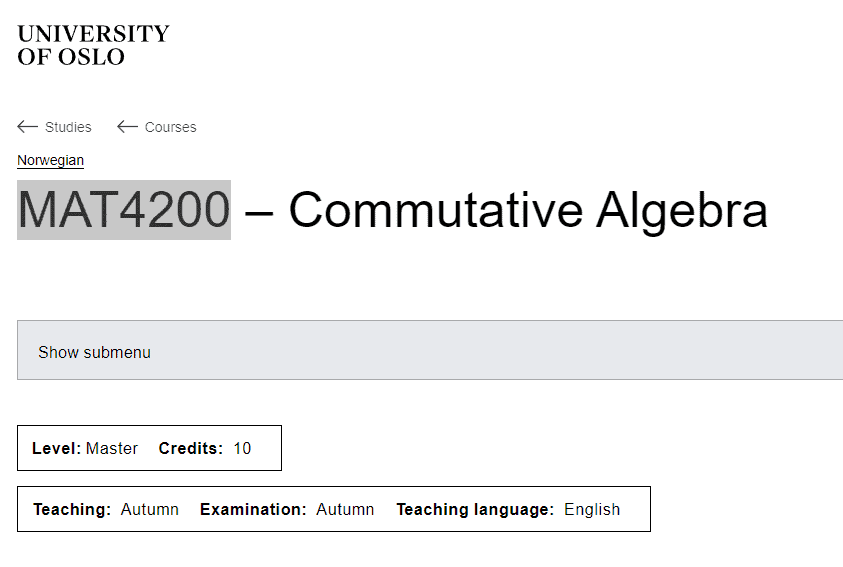数学代写|MAT4200 commutative Algebra
Statistics-lab™可以为您提供uio.no MAT4200 commutative Algebra交换代数的代写代考和辅导服务!

MAT4200 commutative Algebra课程简介
Commutative rings and their modules are important structures in algebraic geometry and number theory, so understanding their properties and structures is crucial for further studies in these areas.
The concept of localization is particularly important in commutative ring theory. Given a commutative ring $R$ and a multiplicatively closed subset $S$ of $R$, the localization of $R$ at $S$, denoted $S^{-1}R$, is a new ring obtained by formally inverting the elements of $S$. Localization allows us to study properties of a ring by restricting attention to a smaller subset of elements. For example, we can use localization to study the behavior of a ring at a prime ideal, which is a fundamental concept in algebraic geometry.
PREREQUISITES
After completing the course you
- know the definition of commutative rings, local rings, prime and maximal ideals, and modules over commutative rings
- are familiar with the notions of noetherian and artinian rings and modules
- know how to localize rings and modules, and are familiar with important applications of localization
- know the Hilbert basis theorem and the Hilbert Nullstellensatz
- are familiar with the concepts of support and associated primes
- know the definition of an exact sequence of modules, and you also know important properties and applications of exact sequences
- know the concept of direct limit and you can compute this limit in some non-trivial examples
- know how to define tensor products of modules and are familiar with the concept of flatness
- know Krull-Cohen-Seidenberg theory
- know the basic results in the dimension theory for local rings
- know how to complete a ring in an ideal.
MAT4200 commutative Algebra HELP(EXAM HELP, ONLINE TUTOR)
Problem 3: Consider the set Spec $\mathbb{C}[x]$ equipped with the Zariski topology.
(1) Show that all maximal ideals of $\mathbb{C}[x]$ are of the form $(x-a)$ for some $a \in \mathbb{C}$.
(2) Show that all prime ideals of $\mathbb{C}[x]$ are either the maximal ideals described above or the zero ideal.
(3) Find the closure of every point in $\operatorname{Spec} \mathbb{C}[x]$.
Hint: The closure of $Y \subset \operatorname{Spec} A$ (defined as the minimal closed subset of Spec $A$ that contains $Y)$ is equal to $Z(I)$, where $I=\bigcap_{p \in Y} \mathfrak{p}$.
(1) Let $I$ be a maximal ideal of $\mathbb{C}[x]$. Since $\mathbb{C}$ is algebraically closed, the quotient ring $\mathbb{C}[x]/I$ is a finite-dimensional $\mathbb{C}$-vector space. By the structure theorem for finitely generated modules over a principal ideal domain, $\mathbb{C}[x]/I$ is isomorphic to a direct sum of cyclic modules of the form $\mathbb{C}[x]/(f)$, where $f$ is an irreducible polynomial in $\mathbb{C}[x]$. Since $I$ is maximal, $\mathbb{C}[x]/I$ is a field, and so each factor $\mathbb{C}[x]/(f)$ must be a field. This implies that $f$ is either a constant polynomial or a linear polynomial of the form $x-a$ for some $a \in \mathbb{C}$. Thus, $I$ is either $(0)$, $(x-a)$ for some $a \in \mathbb{C}$, or $(f)$ for some irreducible polynomial $f$ of degree greater than $1$. But the latter case cannot happen, since $(f)$ is not maximal. Therefore, all maximal ideals of $\mathbb{C}[x]$ are of the form $(x-a)$ for some $a \in \mathbb{C}$.
(2) Let $I$ be a prime ideal of $\mathbb{C}[x]$. If $I$ is the zero ideal, then we are done. Otherwise, $I$ contains a nonzero polynomial $f$. By (1), $I$ is contained in some maximal ideal of the form $(x-a)$. But $f \in (x-a)$ implies that $f(a) = 0$, so $a$ is a root of $f$. Therefore, $I$ is contained in the ideal $(f, x-a)$, which is maximal. Since $I$ is prime, it must be equal to $(f, x-a)$. Therefore, $I$ is of the form $(x-a)$ or $(0)$.
(3) Let $p = (x-a)$ be a point of $\operatorname{Spec} \mathbb{C}[x]$. By the hint, the closure of $p$ is the set $Z(I)$, where $I = \bigcap_{q \in \overline{p}} q$, and $\overline{p}$ is the set of all points containing $p$. Since $\overline{p}$ consists of all maximal ideals containing $p$, we have $\overline{p} = {(x-a)}$. Therefore, $I = \bigcap_{q \in {(x-a)}} q = (x-a)$. The set $Z((x-a))$ is the set of all points of $\operatorname{Spec} \mathbb{C}[x]$ that contain $(x-a)$, which is just ${(x-a)}$. Therefore, the closure of $p$ is $\overline{p} = {(x-a)}$.
Now let $p = (0)$ be a point of $\operatorname{Spec} \mathbb{C}[x]$. Again, by the hint, the closure of $p$ is the set $Z(I)$, where $I = \bigcap_{q \in \overline{p}} q$, and $\overline{p}$ is the set of all points containing $p$. Since $\overline{p}$ consists of all maximal ideals of $\
Problem 4: Let $\mathrm{k}$ be a field and $A=\mathrm{k} \llbracket x \rrbracket$ be the ring of formal power series $f=$ $\sum_{i \geq 0} f_i x^i$ with coefficients in $\mathrm{k}$. Show that
(1) $f \in A$ is invertible $\Longleftrightarrow f_0 \neq 0$.
(2) $f \in A$ is nilpotent $\Longleftrightarrow f=0$.
(3) $A$ contains exactly one maximal ideal $\mathfrak{m}=\left{f \in A \mid f_0=0\right}$.
(4) $R(A)=\mathrm{m}$ and $N(A)=0$.
(1) Assume that $f$ is invertible, i.e., there exists $g \in A$ such that $fg = 1$. Write $f = f_0 + f_1x + f_2x^2 + \cdots$ and $g = g_0 + g_1x + g_2x^2 + \cdots$. Then we have $(f_0 + f_1x + f_2x^2 + \cdots)(g_0 + g_1x + g_2x^2 + \cdots) = 1$. Comparing coefficients of $x^0$, we get $f_0g_0 = 1$, so $f_0 \neq 0$. Conversely, assume that $f_0 \neq 0$. Then we can find $g_0 \in \mathrm{k}$ such that $f_0g_0 = 1$. Define $g = g_0 – g_0f + g_0fg – g_0fg^2 + \cdots = g_0(1-f+fg-fg^2+\cdots)$. It is straightforward to check that $fg=1$.
(2) If $f=0$, then $f^n = 0$ for any $n \geq 1$, so $f$ is nilpotent. Conversely, assume that $f$ is nilpotent, i.e., there exists $n \geq 1$ such that $f^n=0$. Write $f = f_0 + f_1x + f_2x^2 + \cdots$. Then we have $f^n = (f_0)^n + n(f_0)^{n-1}f_1 x + \cdots = 0$. Comparing coefficients of $x^0$, we get $(f_0)^n = 0$, so $f_0 = 0$. Therefore, $f=0$.
(3) It is easy to verify that $\mathfrak{m}$ is a proper ideal of $A$. To show that it is maximal, let $I$ be a proper ideal of $A$ containing $\mathfrak{m}$. Let $f \in I \setminus \mathfrak{m}$, i.e., $f_0 \neq 0$. Then $f$ is invertible by (1), so $1 \in I$, which implies $I=A$. Therefore, $\mathfrak{m}$ is a maximal ideal of $A$.
(4) By (3), $\mathfrak{m}$ is the unique maximal ideal of $A$. Therefore, $R(A) = \mathfrak{m}$. To show that $N(A) = 0$, let $f \in N(A)$, i.e., $f^n = 0$ for some $n \geq 1$. Then $f_0^n = 0$, so $f_0 = 0$. Thus, $f \in \mathfrak{m}$. Since $R(A) = \mathfrak{m}$, we have $f \in R(A)$, which implies $f=0$. Therefore, $N(A) = 0$.
Textbooks
• An Introduction to Stochastic Modeling, Fourth Edition by Pinsky and Karlin (freely
available through the university library here)
• Essentials of Stochastic Processes, Third Edition by Durrett (freely available through
the university library here)
To reiterate, the textbooks are freely available through the university library. Note that
you must be connected to the university Wi-Fi or VPN to access the ebooks from the library
links. Furthermore, the library links take some time to populate, so do not be alarmed if
the webpage looks bare for a few seconds.

Statistics-lab™可以为您提供uio.no MAT4200 commutative Algebra交换代数的代写代考和辅导服务! 请认准Statistics-lab™. Statistics-lab™为您的留学生涯保驾护航。